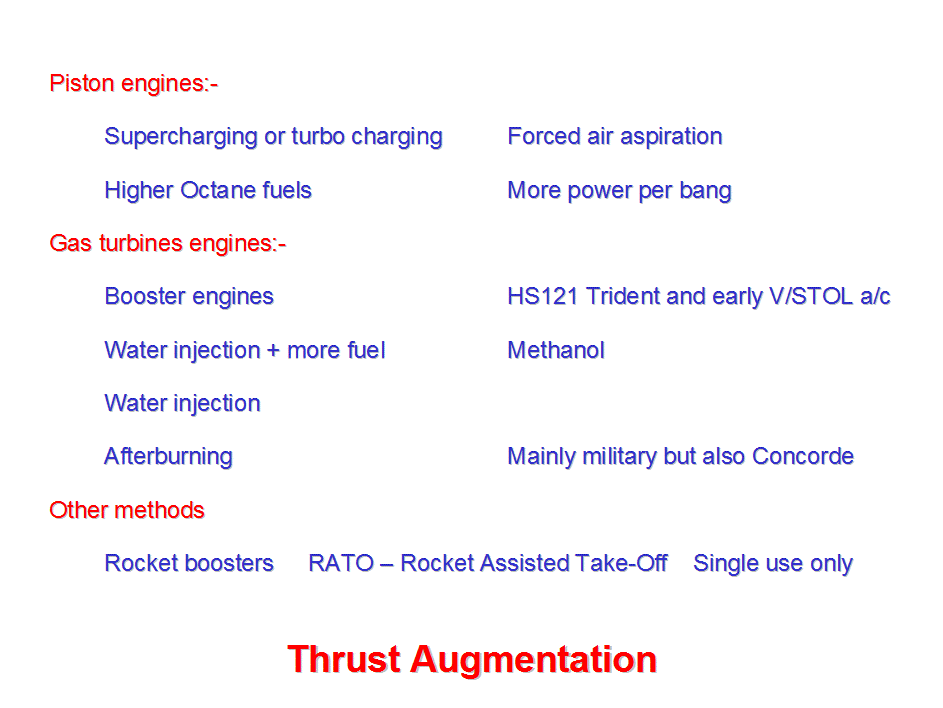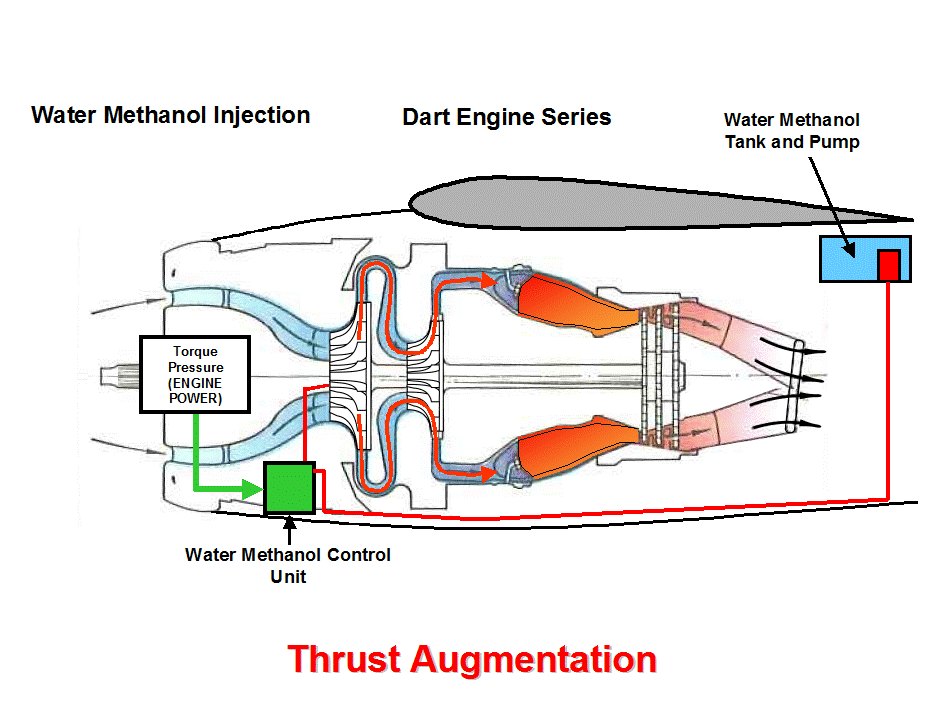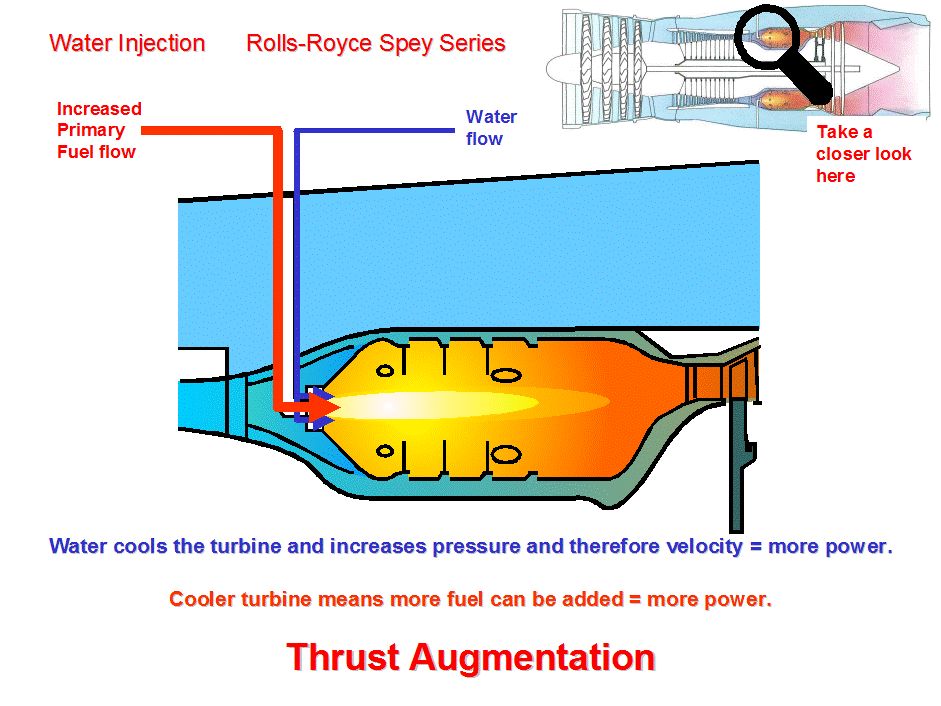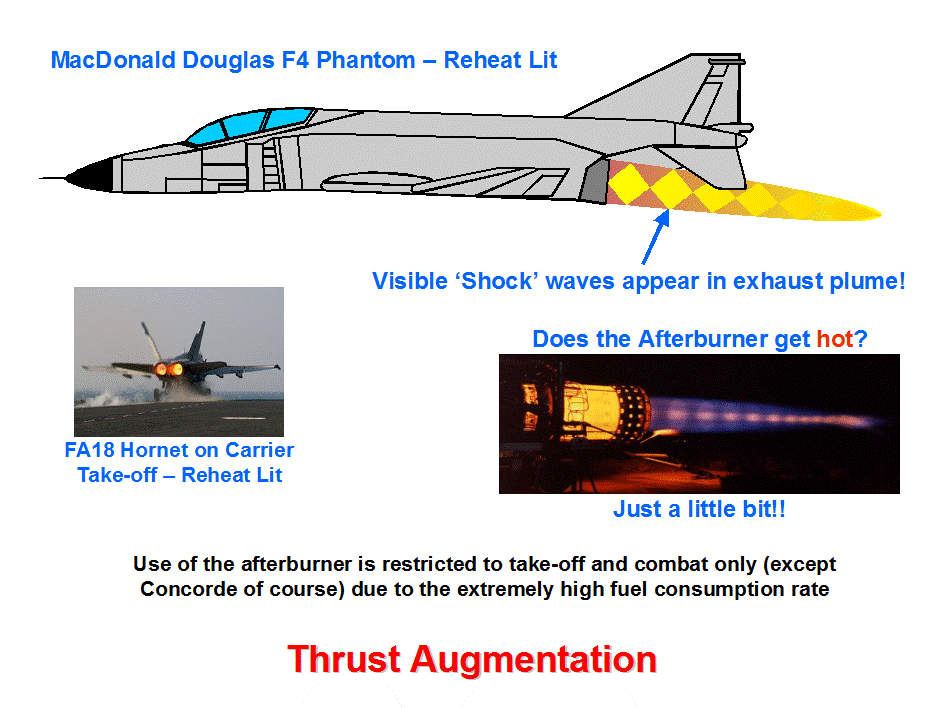INTRODUCTION – THRUST AUGMENTATION
Power increases over and above the normal maximum power level can be provided in various ways, depending on the engine type and technology level.
Power boosting is used mainly for take-off, and in the case of military jet fighters, used during combat to increase speed and survivability.
The exception is Concorde, this was the only passenger jet in service to use reheat, for take-off and transition (acceleration) to supersonic flight. Reheat was not required to maintain supersonic speeds, the engine had enough ‘dry’ power to maintain the higher speeds.
The different forms of power boosting are listed below.
Piston Engines
Refer to section Y PISTON ENGINES
Jet Engines
In this section we will concentrate on the power boosting systems for jet engines.
Extra engines where sometimes fitted to help with take off power such as the Hawker Siddely 121 Trident; a passenger jet with three tail mounted engines, and an additional small booster engine also mounted in the tail.
Some early VERTOL (Vertical Take-Off and Landing) aircraft used booster engines for vertical lift only, mounted vertically in the fuselage or wing tip pods.
Other methods
RATO (Rocket Assisted Take-Off) or JATO (Jet Assisted Take-Off) has been used to get a heavy aircraft off a short runway, such as a transport aircraft, and on jet fighter aircraft to allow faster take-offs and therefore a shorter reaction to an protected airspace threat.
Another method is Steam Catapults used on carrier operations.

WATER METHONAL INJECTION
The system shown below is the system fitted to the Rolls-Royce Dart series turbo-prop engines.
Water injection produces a greater expansion in the combustion chamber and therefore more power.
The water is heated to super heated steam and cools the turbine section.
The cooled turbine means that extra fuel can be added to further increase power, the extra fuel being METHANOL, a combustible alcohol based fluid. The fluid is contained in an nacelle mounted tank sized to allow at least two take-offs.
The use of this system is restricted in terms of the engine ‘life’ as combustion takes place outside of the inner combustion (flame) tube and therefore can accelerate the deteriation rate of the engine combustion section, therefore shortening the engine life.
The methanol is pre-mixed (30% Methanol by weight) with the water and a substance called PYRODINE (1/2% of total) is added to prevent the water-methanol from being consumed, it has the effect of making the water-methanol fluid unpalatable!
Operation
The water-methanol control unit operates everytime take-off power is selected and has two functions: -
In aircraft operational procedures, the only difference between a ‘wet’ take-off (i.e. with water-methanol) and a ‘dry’ take-off is the operation of the water-methanol tank pump; if this is not switched on during pre-take-off checks then a dry take-off will happen.
There are two levels of wet take-off: - Power Restoring, and Power Boosting.
The level of power increase depends on the Mark of the engine and is achieved by control unit mechanical differences and unit adjustments.

WATER INJECTION
The system shown below is the system fitted to the Rolls-Royce Spey series bypass engines.
Water injection produces a greater expansion in the combustion chamber and therefore more power.
The water is heated to super heated steam and cools the turbine section.
The cooled turbine means that extra fuel can be added to further increase power, the extra fuel being engine fuel, i.e. an increase in the rate of fuel into the engine.
The use of this system is restricted in terms of the engine ‘life’ as where, unlike the Dart system previously described, although combustion takes place in the inner combustion (flame) tube as per normal operation, but it can still accelerate the deteriation rate of the engine combustion section, therefore shortening the engine life.
Operation
Selecting a wet power take-off allows water to be injected via additional nozzles built into the fuel spray nozzles. Operation of the water injection system automatically produces a reset of the fuel control unit to allow more fuel to flow.
In aircraft operational procedures, the only difference between a ‘wet’ take-off and a ‘dry’ take-off is the operation of the water injection system; if this is not switched on during pre-take-off checks then a dry take-off will take place.
Injection is effected by throttle micro switches switching on the air driven water pump, flow is controlled by HP compressor pressure via a water flow sensing unit.
There are two levels of wet take-off: - Power Restoring, and Power Boosting.
The level of power increase depends on the Mark of the engine and is achieved by control unit mechanical differences and unit adjustments.

REHEAT SYSTEMS
The illustration below shows a typical Reheat system as fitted to the Rolls-Royce Phantom Spey, the Adour engine in the Jaguar, the RB199 in the Tornado and the EJ2000 in the Typhoon.
Reheat allows the selection of power increase over the basic thrust of the engine for take-off, climb and (for military aircraft) combat performance; and can be selected at any time during the flight.
Operation
Reheat consists of the introduction and burning of fuel between the engine turbine and the jet pipe propelling nozzle, utilizing unburnt oxygen in the exhaust gas to support combustion. The resultant increase in temperature of the exhaust gases gives an increased velocity of the jet leaving the propelling nozzle and therefore increasing engine thrust.
The variable nozzle opens during reheat to maintain jet pipe pressure, therefore not affecting the basic engine (an increase in pressure can lead to lower basic engine power and increase in temperatures; a decrease can lead to engine surge), but, the casings and the engine mounts will need to be able to take the increased thrust produced.
Selecting reheat power is by simply moving the throttle lever through a mechanical gate in the cockpit. Moving the throttle from the normal range into the reheat range does not select a higher RPM etc on the basic engine, it merely controls the reheat power.
Reheat power can be up to 70% higher than basic engine dry power.
There are penalties however, reheat uses a massive amount of fuel, so once again use is restricted to the absolute necessary. One good point is that unlike the previous systems discussed, reheat does not affect the life of the basic engine, as temperatures and RPM are not changed with the increase in power.
REHEAT SYSTEMS
The reheat system consists of a larger diameter jet pipe, with internal heat shields. On a bypass engine cooler bypass air can flow between the heat shields and the jet pipe providing a cooling flow.
Inside there are stabilising burner manifolds and fuel spray tubes.
Ignition is usually via a catalytic igniter; this is a platinum element which ignites fuel on contact. Earlier versions used an electrical igniter or a ‘Hot-shot’ system; i.e. a method of carrying the combustion flame from the engine combustor to the jet pipe.
The variable nozzle is driven by a series of hydraulic rams moving a nozzle operating sleeve backwards and forwards which is fitted around the outside of the jet pipe. The nozzle operating sleeve backwards and forwards movement in turn moves the nozzle interlocking flaps, causing them to open (reheat on) or close (reheat off).
REHEAT SYSTEMS (Cont’d)
Below can be seen various aircraft with reheat on.
At the time it was produced, the Spey powered Phantom was the only aircraft to produce the diamond pattern shock waves in the exhaust plume.
Bottom right is a photograph taken of a Lockheed SR71 Blackbird in full reheat, and left to test duration. It is plainly obvious that the jet pipe gets very hot during extended operation. The darker lines silhouetted around the outside will be the hydraulic pipes to the nozzle operating rams, the rams themselves and the nozzle sleeve. Also visible are similar visible shock waves in the exhaust plume

Source: http://www.299exmouth.com/wp-content/uploads/CHAPTER-8-NOTES-1.doc
Web site to visit: http://www.299exmouth.com
Author of the text: not indicated on the source document of the above text
If you are the author of the text above and you not agree to share your knowledge for teaching, research, scholarship (for fair use as indicated in the United States copyrigh low) please send us an e-mail and we will remove your text quickly. Fair use is a limitation and exception to the exclusive right granted by copyright law to the author of a creative work. In United States copyright law, fair use is a doctrine that permits limited use of copyrighted material without acquiring permission from the rights holders. Examples of fair use include commentary, search engines, criticism, news reporting, research, teaching, library archiving and scholarship. It provides for the legal, unlicensed citation or incorporation of copyrighted material in another author's work under a four-factor balancing test. (source: http://en.wikipedia.org/wiki/Fair_use)
The information of medicine and health contained in the site are of a general nature and purpose which is purely informative and for this reason may not replace in any case, the council of a doctor or a qualified entity legally to the profession.
The following texts are the property of their respective authors and we thank them for giving us the opportunity to share for free to students, teachers and users of the Web their texts will used only for illustrative educational and scientific purposes only.
All the information in our site are given for nonprofit educational purposes
The information of medicine and health contained in the site are of a general nature and purpose which is purely informative and for this reason may not replace in any case, the council of a doctor or a qualified entity legally to the profession.
www.riassuntini.com